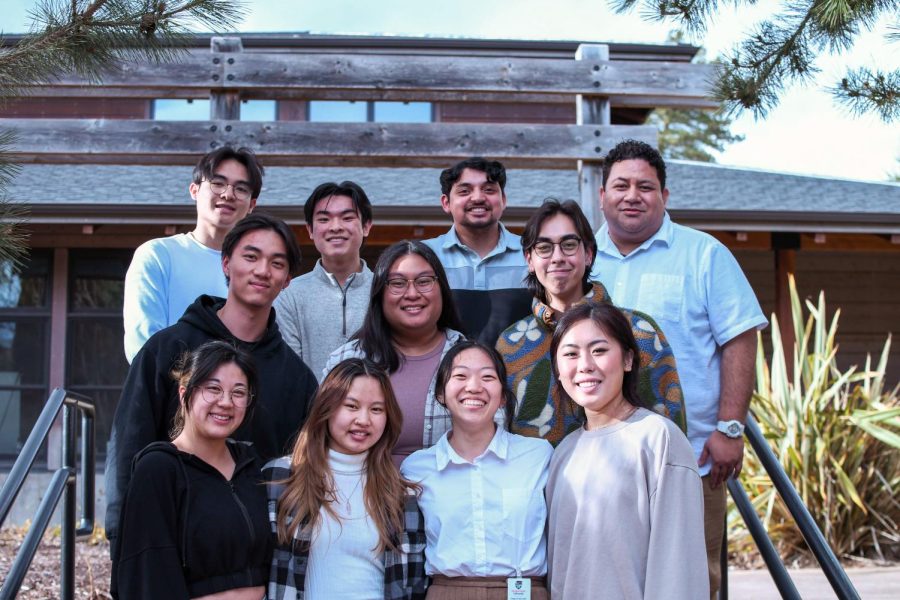Asian American and Pacific Islander Heritage Month: A month of cultural identity pride and continued education
Oregon State Asian American and Pacific Islander (AAPI) staff posed in front of the Asian and Pacific Cultural Center (APCC) before their weekly meeting. From top to bottom and left to right, the members included are: Dylan Luong, Stanley Luu, Karthik Vijay, Lipo Sinapati, Eric Kong, Lei Bugarin, Geoffrey Engel, Bekah Rocak, Alex Dinges, Kayla Kurahashi, Katelyn Nguyen.
April 27, 2023
Asian American and Pacific Islander Heritage month is known as a time to celebrate the ways AAPIs have contributed to history, but at Oregon State University, the month of May is also a time to learn about the numerous communities held within the identity.
“Everyone has a different process of what education looks like to them, because everyone’s identity is so different,” said Geoffrey Engel, Asian and Pacific Cultural Center community relations representative.
Engel described how the experience of learning history within one culture can look very different from another, especially between cultures or countries that have more documented history. An example being learning about Japanese history versus history of events within Laos which Dylan Luong, APCC leadership liaison, mentioned are learned about from speaking with elders in the community.
“A lot of it is about pride,” Engel said. “A lot of people growing up in a predominantly white area aren’t taught to embrace (their cultural identity), usually your AAPI identity would usually be a point of alienation and if you lean into that you are more progressively alienated. So if you have a heritage month that promotes a time of learning and it tells you to embrace that and that it is something to be proud of… in constructs your understanding of yourself and I think it can also help validate your lived experiences when you have that academic literature and terminology to put a name to your experiences it can be empowering in that sense.”
While the APCC plans to host a variety of events highlighting different cultures included in AAPI community, not one person holds all of the knowledge of contributions that the community as a whole have made at OSU or even nationwide.
AAPI heritage month foundational history:
According to the National Endowment for the Humanities, the month of May has been specifically dedicated to AAPI Heritage in order to commemorate the immigration of the first Japanese to the US on May 7, 1843 and to mark the anniversary of the completion of the transcontinental railroad on May 10, 1869, as majority of these workers who laid the tracks were Chinese immigrants.
The NEH claims that the term “Asian American” was coined in 1968 by student activists Emma Gee and Yuji Ichioka as a unifying political identity for people of Asian descent, in order to push back on the previous Euro-centric term.
Those that identify themselves in this community claim that how words used to describe them were in direct correlation to being empowered to continue supporting civil rights efforts in the 1960s.
It was during the Civil Rights Movement that the community began to speak out on issues that were prominent and significant to their communities, which was previously unheard of before.
According to the NEH, “1960s Asian American civil rights activism…signaled a shift from Asian Americans fighting for the right to be Americans, to fighting for their rights as Americans.”
Malcolm X’s ideologies influenced many Asian Americans through the movement and on May 19, 1972, Yuri Kochiyama did an interview with a radio station, KPFK in Los Angeles, where Kochiyama acknowledged Malcolm’s stress on needing to know one’s heritage and history to know which direction to go in.
With this, Asian American students in California challenged the curriculum of higher education, arguing that research and teaching had propagated stereotypes about AAPI education history and culture.
In 1968, at San Francisco State University, and in 1969 at the University of California, Berkeley, Asian Americans joined the Third World Liberation Front student strikes alongside the Black Students Union and other student groups.
The strikes were used to demand that the universities hire more faculty of color, enroll more students of color and create departments devoted to ethnic studies. It was during this time that the Asian American Political Alliance was established at the UC Berkeley campus.
Soon, AAPA branches were on college campuses nationwide. The AAPA was disbanded in 1969, however, the intention had been met–Asian American identity was declared.
“I think that there’s probably a really significant amount of history that’s not documented,” Engel said.
Although the AAPA is no longer a running organization, across the country, Asian American and Pacific Islander communities have been able to create safe spaces where anyone who identifies as API can find a source of connection.
OSU AAPI history and today:
Here at Oregon State University, according to Alexis “Alex” Dinges, communications representative, the initiative for an Asian Cultural Center started as early as the 1980s, but was officially established in 1991.
Originally just the Asian Cultural Center, in 2003, it was re-established as the Asian and Pacific Cultural Center to be more inclusive of the API identity.
Previously, the center was located on Jackson St. but following the building of a new space in 2014, the APCC moved to where it currently resides in 2015 and the area was opened to the public.
“That was really important, because a lot of the centers were built around the same time, like the BCC, Centro…it took [the centers] from being kind of like cast out to the outskirts to being really central on campus,” Dinges said.
According to Luong and Engel, having a heritage month promotes a time of learning and teaches individuals how to embrace heritage.
“It’s a point to be proud of,” Engel said.
The AAPI community represents over 60+ countries and ethnic groups that speak over 100 different languages. Geographically, AAPI encompasses all of the Asian continent and Pacific Islands of a multitude of nations;
- Melanesia
- Papua New Guinea
- New Caledonia
- Vanuatu
- Fiji
- Solomon Islands
- Micronesia
- Northern Mariana Islands
- Guam
- Wake Island
- Palau
- Marshall Islands
- Kiribati
- Nauru
- Federated States of Micronesia
- Polynesia
- New Zealand
- Hawaiian Islands
- Rotuma
- Midway Islands
- Samoa
- American Samoa
- Tonga
- Tuvalu
- Cook Islands
- French Polynesia
- Easter Island
With so many ethnicities, that doesn’t mean alienation isn’t possible.
“It’s a very conscious process,” Engel said.
According to Dylan Luong, APCC leadership liaison, the center is aware of their limitations, especially with only 10 student representatives at the center.
“…Our staff definitely isn’t shy of reaching out to other communities if we feel like we’re past our knowledge,” Dinges said.
Through community, the APCC has been able to widen the scope of their inclusivity, as they also stay in communication and work in collaboration with the API Council. This council is made up of the numerous cultural clubs that help those who are looking to see representation while here at OSU.
Through various events put on by the center in honor of celebrating heritage month, individuals in the community are hosting different events to showcase the different cultures at OSU.
Some events are currently ongoing, such as “Fashioning API Identity,” which was set up in the APCC by Engel as a project for the center. The rotating fashion display is a partnership with the Apparel Textile Collection at OSU. Beginning with Korea, which displayed from April 5 to May 1, India will be displayed for two weeks, concluding the year with China.
This is an in-house display that individuals can come in and explore whenever, as the garments are permanently at the center, to talk about the significance in the original culture contexts.
To honor AAPI heritage month the center will also be hosting a number of informational events, such as The Secret Wars, Nishihara Classroom Naming Reception, Roots of Resilience: A Hiroshima Peace Tree Documentary and APASU Culture Shock.
Events APCC is holding for API Heritage Month
May 1: APIDA Heritage Month Kickoff
Taking place in the Student Experience Center Plaza, in between the SEC and the Memorial Union from 11:30 a.m. – 1:30 p.m., the APCC is holding their kickoff to heritage month. Join students as they celebrate the beginning of the month with additional knowledge of the events to come throughout the month.
May 8: API Film showing at APCC (film TBD)
Throughout the month of May, the APCC will be hosting a Monday Matinee Movie Series during the lunch hour(s) with the focus on APIDA themed cinema. At this time, the films have yet to be determined.
May 10: The Secret Wars: Untold Stories
Dylan Luong, Leadership Liaison for the APCC, will be hosting an informational event concerning the coined, “Secret Wars” that have happened within history, such as the U.S. conducting an air bombing campaign against Laos just before the Vietnam war. This bombing, which was used in hopes to destroy a potential trail that Viet Cong used, but instead, bombed schools, hospitals and civilian homes.
The Secret Wars informational event will be held in the MU Horizon Room from 6 p.m. – 8:30 p.m.
May 12: Nishihara Classroom Naming Reception
May 13: Pilipino Culture Night (IBP)
Pilipino Culture Night is a student organized cultural event put on by the Isang Bansang Pilipino club.
Pilipino Culture Night will be held at the MU Ballroom from 6 p.m-8 p.m.
May 15: API Film showing at APCC (film TBD)
Throughout the month of May, the APCC will be hosting a Monday Matinee Movie Series during the lunch hour(s) with the focus on APIDA themed cinema. At this time, the films have yet to be determined.
May 18: Roots of Resilience: A Hiroshima Peace Tree Documentary
David-Paul B. Hedberg, an independent historian in Portland, Or, will be a keynote speaker for the Roots of Resilience event.
The Roots of Resilience will take place at 5 p.m.-8p.m. at the MU Ballroom
May 21: APASU Culture Shock
The Asia Pacific American Student Union is hosting their signature event of the year, displaying API representation at OSU to show performances and an art gallery put together by different API identities across campus.
APASU Culture Shock will begin at 5p.m. and run until 7p.m. in the MU Ballroom.
May 22: API Film showing at APCC (film TBD)
Throughout the month of May, the APCC will be hosting a Monday Matinee Movie Series during the lunch hour(s) with the focus on APIDA themed cinema. At this time, the films have yet to be determined.
May 23: Pasifika Fest
Pasifika Fest will be taking place at the SEC Plaza, 5 p.m.-8 p.m.
Jun 3: APCC Night Market
Taking place in June will be the APCC Night Market, where the center puts together performances, food vendors, raffles and cake. This will be the center’s second time doing the market, but they intend to make it an annual event where they can display all of the clubs and API culture.
The APCC Night Market will be taking place in the SEC Plaza, 4 p.m.-7 p.m.
Jun 10: API Graduation Celebration
























































































































